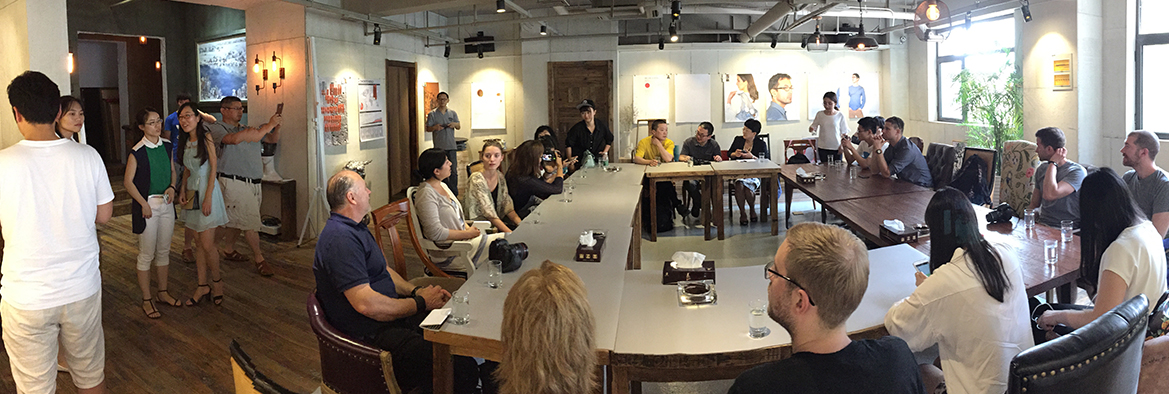For UW design students participating in an exchange program in China this summer, discussions with Chinese students about design were eye-opening. But the exchange really took flight when the two groups shared long bus rides and evenings of karaoke.
“Our students had a chance to really experience the similarities and differences between the two cultures that went way beyond their design projects,” says Christopher Ozubko, professor of design in the School of Art + Art History + Design (SoA+AH+D), who organized the exchange. “They were adventurous and spent time with the Chinese students, learning about their lives. Those are experiences you can’t get as a tourist.”
Ozubko has seen the benefit of such student exchanges before, including two previous exchanges in China. The first, offered nearly 15 years ago, brought together design faculty and students from the UW and Tsinghua University in Beijing. Students designed posters at their home university around a shared theme, and faculty planned week-long design workshops at each other’s school. UW faculty taught their workshop in Beijing, but when Tsinghua faculty were unable to reciprocate due to bureaucratic glitches in China, a new plan emerged. “We all agreed to use the grant money to bring our students over to China instead,” says Ozubko, who was thrilled to offer his students such an opportunity.

More than a decade later, Professor Zhang Zhixian at Southeast University (SEU) in Nanjing proposed a similar exchange after spending a year at the UW as a visiting scholar. Students once again designed posters with a shared theme, but this time—with support from SEU and the Ministry of Education of China—faculty and students from both universities had the opportunity to travel across the Pacific when the posters were exhibited in Nanjing and then at SoA+AH+D’s Sand Point Gallery.
The program was offered in 2013 and again this summer, with a graduate studio course anchoring the experience this year. The UW students, as well as their peers in Nanjing, designed two-sided posters exploring the theme of “Earth.” On one side they offered a visually persuasive message; on the other, detailed data supporting that message.

Most students spent the bulk of their project time selecting and researching an Earth-related topic. One poster compared the land and water resources required to raise lamb, chicken, and beef. Another highlighted the amount of water sold on the UW campus and what happens to the bottles after use. For a poster about carbon emissions generated during the production of concrete, the designer explored options for reducing concrete in buildings. Though they were packed with information, the posters were skillfully designed so that the overarching message resonated.
“Designers take complex ideas and present them in a way that provokes inquiry,” says Ozubko. “They should draw you in for a little bit more discovery. The goal is to get people interested in learning more about the issue.”
UW students Chad Hall and Catherine Lim worked collaboratively on a poster that incorporated product design, proposing wearable items built upon existing technologies. With a bit of humor, they imagined a miniaturized wind turbine to be worn on the shoulder, an epidermal patch to increase the wearer’s empathy, and a vest and catheter combination that would filter urine into drinking water. “Our intention was to ask why we don't take more drastic measures on our own bodies to decrease our impact on natural resources,” explains Lim. “The tactics of fashion and advertising were used to present these ridiculous — yet still feasible and believable — products in an appealing way, as if extreme sustainability could be some kind of status symbol. The humor in the tone was a way for us to provoke conversation.”

When the UW students traveled to Nanjing to share their posters, the cultural differences were obvious, with the SEU students putting a different spin on the “Earth” theme. “Earth to them seemed to have a much more central focus on actual soil and physical space,” says Hall. “Many of us had interpreted Earth to be a holistic entity and ecosystem, which is how many of us actually focused on human behavior and how it affects the Earth as an ecosystem.”
The different perspective led to some unexpected responses. In a poster about carbon emissions and trade, UW student Geoff Gray suggested that westerners buying products made in China should take ownership of carbon emissions associated with the manufacture of those products. To his surprise, the SEU students thought the message was that China is shipping pollution around the world. “Having a chance to explain the poster changed their attitudes almost instantly,” Gray says.

Students in China also interact with their professors differently than students in the U.S., as Ozubko learned while leading workshops there through the years. “The students never present their work and talk about it in a group,” he says. “They don’t have a critique system. And they never question their professors. At American universities, students learn to discuss, debate, and take criticism from each other as well as the instructor.”
Despite their differences, the SEU and UW students did find common ground. As they spent more time together, they discussed everything from music and relationships to selfie sticks and politics — and of course, design. “Everyone there was very hospitable and constantly went above and beyond for us in a very genuine way,” says Hall.
The UW students look forward to returning the favor. In November all of the posters will be exhibited at the UW’s Sand Point Gallery, with SEU faculty and students traveling from China to Seattle for the opening. Ozubko hopes the visit will be one of many to come. “Zhang and I hope to do this exchange every other year,” he says. “It’s wonderful to have this ongoing connection with designers across the Pacific.”
. . .
The UW-SEU posters will be exhibited at UW's Sand Point Gallery on November 16, with a reception from 6:30 to 8:30 pm. For more information, visit the School of Art+Art History+Design website.